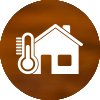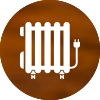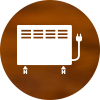If you’re not in the energy-saving business by trade, the title of this blog probably introduced you to a couple of new phrases. “Radiant?” “Forced-air?” What is this, high school chemistry? Have no fear. The concepts are relatively straightforward. As our friends at Green Builder explain in this handy-dandy webinar, “Radiant Heating” is a key component in hydronic radiant floor heating systems, i.e., systems that heat your home primarily through heat conducted by water. More on them in a minute.
“Forced-air,” on the other hand, is the form of heating system that is found in 95 percent of all homes in America. In these systems—in a nutshell—cold air comes in and the system uses fuel (most of the time of the fossil variety) to heat the air. The air then heats you and your family.
But is this the most efficient way to heat? Steve Swanson, the national trainer for Uponor Academy, one of the country’s foremost suppliers of radiant heating systems, does not think so. “Air is one of the worst conductors of heat that there is,” he said. Because water offers so much more in terms of heat conductivity, could it be that radiant systems are also more efficient? Let’s explore.
Forced-air systems create convection currents, which make for inconsistent temperatures
 “Convection currents?” Again with the science words! But stay with us. As you may know, hot air rises and cool air falls. In forced-air systems, this means that hot air is constantly drifting toward the ceiling, where it cools and then falls to the floor. In the winter, the hottest part of any forced-air home is the ceiling.
“Convection currents?” Again with the science words! But stay with us. As you may know, hot air rises and cool air falls. In forced-air systems, this means that hot air is constantly drifting toward the ceiling, where it cools and then falls to the floor. In the winter, the hottest part of any forced-air home is the ceiling.
In radiant homes, however, this dynamic does not exist. Temperatures are consistent throughout a given room, which means you won’t perceive your own home to be drafty. Fewer drafts means fewer trips to crank up that thermostat, which means lower energy costs.
Bang for your buck in unexpected ways
 But it’s not just energy costs! Air filtering systems pose problems you may not have considered. For instance, as Swanson puts it in the webinar we link to above, “When you buy a typical, inexpensive forced-air furnace you’re going to get a disposable fiberglass furnace that doesn’t meet a single healthcare facility standard. It will filter some dirt and dust, but none of the microbial issues or harmful gases that are passed around are trapped by them.” Considering that 90 percent of our time is spent indoors and bad indoor air quality is a major health hazard, perhaps we should spend more time thinking about the air in our homes. If we don’t we could rack up some serious healthcare costs.
But it’s not just energy costs! Air filtering systems pose problems you may not have considered. For instance, as Swanson puts it in the webinar we link to above, “When you buy a typical, inexpensive forced-air furnace you’re going to get a disposable fiberglass furnace that doesn’t meet a single healthcare facility standard. It will filter some dirt and dust, but none of the microbial issues or harmful gases that are passed around are trapped by them.” Considering that 90 percent of our time is spent indoors and bad indoor air quality is a major health hazard, perhaps we should spend more time thinking about the air in our homes. If we don’t we could rack up some serious healthcare costs.
Of course, hydronic heating systems cost more up front. But the long-term savings—and everyday comfort—are nothing to sneeze at. If you’re looking for a new way to heat your home, a radiant system might be the way to go.


 By far, the most popular way to heat a home is with a furnace or boiler. Furnaces heat air and distribute it through the house using ducts. Boilers heat water, which is delivered through baseboard radiators or a radiant floor system, or heat air through a coil.
By far, the most popular way to heat a home is with a furnace or boiler. Furnaces heat air and distribute it through the house using ducts. Boilers heat water, which is delivered through baseboard radiators or a radiant floor system, or heat air through a coil. Heat pumps—Heat pumps move heat instead of generating it. They use electricity to move heat from a cool space to a warm space, so the cool space is cooler and the warm space is warmer. In the winter, heat pumps move heat from the cool outdoors into your warm house. Conversely, in the summer, heat pumps move heat from your cool house into the warm outdoors.
Heat pumps—Heat pumps move heat instead of generating it. They use electricity to move heat from a cool space to a warm space, so the cool space is cooler and the warm space is warmer. In the winter, heat pumps move heat from the cool outdoors into your warm house. Conversely, in the summer, heat pumps move heat from your cool house into the warm outdoors. Solar Energy—As its name implies, active solar heating uses the natural energy from the sun to heat either liquid or gas, and then transfers this solar heat to a storage system for later use.
Solar Energy—As its name implies, active solar heating uses the natural energy from the sun to heat either liquid or gas, and then transfers this solar heat to a storage system for later use. Electric Resistance Heating—This system is 100 percent energy-efficient because it converts all the incoming electric energy into heat. But it is also among the costliest, because most of the electricity is generated from coal, gas, or oil, which has a fuel-to-electricity conversion rate of only about 30 percent.
Electric Resistance Heating—This system is 100 percent energy-efficient because it converts all the incoming electric energy into heat. But it is also among the costliest, because most of the electricity is generated from coal, gas, or oil, which has a fuel-to-electricity conversion rate of only about 30 percent. Wood and Pellet Heating—Today’s generation of wood- and pellet-burning appliances are more efficient and powerful enough to heat most average-sized homes. They also burn cleaner.
Wood and Pellet Heating—Today’s generation of wood- and pellet-burning appliances are more efficient and powerful enough to heat most average-sized homes. They also burn cleaner. Steam and Hot Water Radiators—Steam radiators are one of the oldest heating systems around. However, the process of boiling and condensing liquid into heat is not as efficient as more modern-day systems. Hot water radiators are very popular in newer homes. The most common types are baseboard or upright style.
Steam and Hot Water Radiators—Steam radiators are one of the oldest heating systems around. However, the process of boiling and condensing liquid into heat is not as efficient as more modern-day systems. Hot water radiators are very popular in newer homes. The most common types are baseboard or upright style. Radiant Heating—Radiant heating systems deliver heat directly from a hot surface to people and objects in the room through infrared radiation. If you have ever felt heat from across the room from a stove top, you’ve experienced radiant heating.
Radiant Heating—Radiant heating systems deliver heat directly from a hot surface to people and objects in the room through infrared radiation. If you have ever felt heat from across the room from a stove top, you’ve experienced radiant heating. Portable Heaters—When you need to supplement an inadequate heating system or central heat is cost prohibitive, portable heaters are a good alternative, especially if you only need to heat one room. Take safety considerations when purchasing one by making sure it:
Portable Heaters—When you need to supplement an inadequate heating system or central heat is cost prohibitive, portable heaters are a good alternative, especially if you only need to heat one room. Take safety considerations when purchasing one by making sure it: